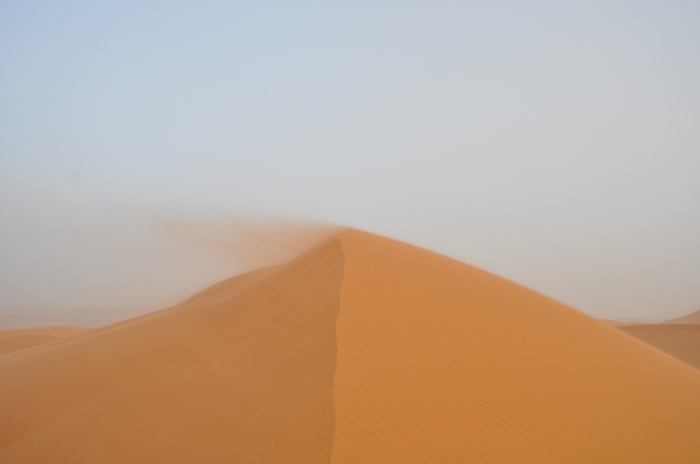"Each year, hundreds of millions of tons of exposed soil from the Sahara Desert lifts into the air on gusts of wind. Once those dust particles are airborne, they may travel thousands of miles, affecting weather and air quality as far away as Europe and even the Americas."
Read the full article below or on ScienceNode.org: https://sciencenode.org/feature/Tracking...
Tracking dust around the globe
- Dust particles travel long distances and have major atmospheric impact
- Ground-based remote sensing may reveal unexpected alignment of dust particles
- Better understanding of dust behavior may have implications for climate change
Each year, hundreds of millions of tons of exposed soil from the Sahara Desert lifts into the air on gusts of wind. Once those dust particles are airborne, they may travel thousands of miles, affecting weather and air quality as far away as Europe and even the Americas.
Traveling Saharan dust can make for beautiful sunsets and help fertilize the Amazon rainforest. But these tiny particles (no larger than 1/10th the width of a human hair) may also have an impact on global climate and weather patterns.
Dust and other airborne particles (aerosols) from wildfires, cement production, and fossil fuel combustion affect the brightness and thickness of clouds and precipitation. In high concentrations near the planet’s surface they are components of pollution, reducing visibility and endangering the health of the people who breathe them in.
This outsize impact gives scientists a lot of reasons to study dust. They particularly want to know why it stays in the air long enough to travel around the globe instead of settling back to the ground near where it was produced.

Scientists in Greece are well-positioned for this research because they are comparatively close to the Sahara and can accurately measure dust particles with ground-based instruments.
“Just a few weeks ago, we had so much dust that it seemed like there was heavy cloud cover,” says Alexandra Tsekeri, a researcher working on the team of Vassilis Amiridis at the National Observatory of Athens. “But it was clear sky obscured by dust.”
Collecting information about dust
“Dust is very interesting,” says Tsekeri. “It’s the most complicated aerosol particle because of its irregular shape and large size. Due to these characteristics, there remain a lot of unsolved issues for dust remote sensing.”
Remote sensing is the science of obtaining information about objects from a distance by detecting the light scattered from those objects. This often means collecting data from satellites or aircraft using radar or lidar. But ground-based instruments can also be used for close-range characterization and for monitoring atmospheric phenomenon such as dust.

One of the aspects of dust that Amiridis’s team is investigating is alignment. They hypothesize that dust transports at longer distances than expected because electrical fields in the dust counteract gravitational settling. Due to those electrical fields, the dust then becomes aligned, or oriented in a particular manner.
To test their hypothesis, the team has organized dedicated experimental campaigns in Cape Verde (summer 2020) and at the PANGEA observation station on the island of Antikythera in the eastern Mediterranean. The island’s low elevation and proximity to diverse dust sources make it ideal for dust monitoring. These efforts receive support from the European Research Council and the European Space Agency.
For monitoring the dust orientation the team has collaborated with Volker Freudenthaler of LMU and Raymetrics lidar company. They have designed and constructed a new ground-based polarization lidar that specifically targets the alignment of dust particles in the atmosphere, by measuring different polarization states of the backscattered light.
“The aligned dust particles have very characteristic polarization properties in the backscatter, compared to randomly-oriented dust particles,” says Tsekeri. “Thus, by targeting these properties with our new polarization lidar we expect to measure clear indications of dust alignment in the atmosphere.”
From tiny to giant dust particles
“My research has to do with how we monitor dust more effectively,” says Tsekeri. “Right now, we have data from ground-based instruments and satellites that we aren’t able to interpret correctly because we do not have realistic models for dust in terms of size and shape.”
 This is due to the extensive computing power required to calculate the backscatter of dust particles. Tsekeri and her colleagues have been granted high-performance computing (HPC) resources from PRACE (Partnership for Advanced Computing in Europe) and currently run simulation models on MareNostrum at Barcelona Supercomputing Center and ARIS, the Greek national supercomputer.
This is due to the extensive computing power required to calculate the backscatter of dust particles. Tsekeri and her colleagues have been granted high-performance computing (HPC) resources from PRACE (Partnership for Advanced Computing in Europe) and currently run simulation models on MareNostrum at Barcelona Supercomputing Center and ARIS, the Greek national supercomputer.
“There is a lot to be done in dust remote sensing research that hasn’t been done because of the computational resources needed,” says Tsekeri. “That’s why we need the HPC.”
She continues, “It’s very important to have the whole big picture of what is going on globally with dust because it’s an atmospheric agent that transports nutrients and affects cloud and affects the climate by reflecting or absorbing incoming solar radiation.”
If the team is able to successfully model dust behavior on a large scale, it will be useful not just for climate modeling here on earth but has potential applications for atmospheric dust research on Mars, the Moon, and asteroids.
Read more:
This article was originally published on ScienceNode.org. Read the original article.


